Review of the Yb3+:ScBO3 Laser Crystal Growth, Characterization, and Laser Applications
Abstract
:1. Introduction
2. Bulk Crystal Characteristics
2.1. Crystal Structure
2.2. Crystal Growth
2.3. Thermal Characteristics, Laser Damage Threshold and Mechanical Characteristics
2.4. Spectroscopic Characteristics
2.5. Continuous Laser Performance
2.6. Q-Switching Laser Performance
3. Conclusions
Supplementary Materials
Author Contributions
Funding
Institutional Review Board Statement
Informed Consent Statement
Data Availability Statement
Conflicts of Interest
References
- Holzrichter, J.F.; Eimerl, D.; George, E.V.; Trenholme, J.B.; Simmons, W.W.; Hunt, J.T. High Power Pulsed Lasers. J. Fusion Energy 1982, 2, 5–45. [Google Scholar] [CrossRef]
- Moskalik, K.; Kozlov, A.; Demin, E.; Boiko, E. The Efficacy of Facial Skin Cancer Treatment with High-Energy Pulsed Neodymium and Nd:YAG Lasers. Photomed. Laser Surg. 2009, 27, 345–349. [Google Scholar] [CrossRef] [PubMed]
- Kumkar, M.; Bauer, L.; Russ, S.; Wendel, M.; Kleiner, J.; Grossmann, D.; Bergner, K.; Nolte, S. Comparison of Different Processes for Separation of Glass and Crystals Using Ultrashort Pulsed Lasers. Proc. SPIE 2014, 8972, 897214. [Google Scholar]
- Maharjan, N.; Zhou, W.; Zhou, Y.; Guan, Y.; Wu, N. Comparative Study of Laser Surface Hardening of 50CrMo4 Steel Using Continuous-Wave Laser and Pulsed Lasers With Ms, ns, Ps and Fs Pulse Duration. Surf. Coat. Technol. 2019, 366, 311–320. [Google Scholar] [CrossRef]
- McKenzie, R.L. Measurement Capabilities of Planar Doppler Velocimetry Using Pulsed Lasers. Appl. Opt. 1996, 35, 948–964. [Google Scholar] [CrossRef]
- Baac, H.W.; Uribe-Patarroyo, N.; Bouma, B.E. High-Energy Pulsed Raman Fiber Laser for Biological Tissue Coagulation. Opt. Express 2014, 22, 7113–7123. [Google Scholar] [CrossRef] [PubMed] [Green Version]
- Dergachev, A.; Armstrong, D.; Smith, A.; Drake, T.; Dubois, M. 3.4-μm ZGP RISTRA Nanosecond Optical Parametric Oscillator Pumped by a 2.05-μm Ho:YLF MOPA System. Opt. Express 2007, 15, 14404–14413. [Google Scholar] [CrossRef]
- Axenson, T.J.; Barnes, N.P.; Reichle, D.J.; Koehler, E.E. High-Energy Q-Switching 0.946-µm Solid-State Diode Pumped Laser. J. Opt. Soc. Am. B 2002, 19, 1535–1538. [Google Scholar] [CrossRef]
- Zhang, X.; Zhao, S.; Wang, Q.; Ozygus, B.; Weber, H. Modeling of Passive Q-Switching Lasers. J. Opt. Soc. Am. B 2000, 17, 1166–1175. [Google Scholar] [CrossRef]
- Zayhowski, J.J. Passive Q-Switching Nd:YAG Microchip Lasers and Applications. J. Alloy. Compd. 2000, 303, 393–400. [Google Scholar] [CrossRef]
- Huang, H.; Li, M.; Wang, L.; Liu, X.; Shen, D.; Tang, D. Gold Nanorods as Single and Combined Saturable Absorbers for a High-Energy Q-Switching Nd:YAG Solid-State Laser. IEEE Photonics J. 2015, 7, 1–10. [Google Scholar]
- Han, M.; Zhang, S.; Li, X.; Zhang, H.; Wen, F.; Yang, Z. High-Energy, Tunable-Wavelengths, Q-Switching Pulse Laser. Opt. Commun. 2014, 326, 24–28. [Google Scholar] [CrossRef]
- Keller, U.J. Recent Developments in Compact Ultrafast Lasers. Nature 2003, 424, 831–838. [Google Scholar] [CrossRef]
- Zhang, Y.; Lu, D.; Yu, H.; Zhang, H.J. Low-Dimensional Saturable Absorbers in the Visible Spectral Region. Adv. Opt. Mater. 2019, 7, 1800886. [Google Scholar] [CrossRef] [Green Version]
- Gehring, G.A.; Gehring, K.A. Co-Operative Jahn-Teller Effects. Rep. Prog. Phys. 1975, 38, 1–89. [Google Scholar] [CrossRef]
- Haumesser, P.-H.; Gaumé, R.; Viana, B.; Antic-Fidancev, E.; Vivien, D. Spectroscopic and Crystal-Field Analysis of New Yb-Doped Laser Materials. J. Phys. Condens. Matter 2001, 13, 5427–5447. [Google Scholar] [CrossRef]
- Liu, W.; Lu, D.; Guo, R.; Wu, K.; Pan, S.; Hang, Y.; Sun, D.; Yu, H.; Zhang, H.; Wang, J. Broadening of the Fluorescence Spectra of Sesquioxide Crystals for Ultrafast Lasers. Cryst. Growth Des. 2020, 20, 4678–4685. [Google Scholar] [CrossRef]
- Kalisky, Y.; Kalisky, O.; Rachum, U.; Boulon, G.; Brenier, A. Comparative Performance of Passive Q-Switching Diode-Pumped Yb3+-Doped Tungstate and Garnet Lasers Using Cr4+:YAG Saturable Absorber. IEEE J. Sel. Top. Quantum Electron. 2007, 13, 502–510. [Google Scholar] [CrossRef]
- Liu, J.; Tian, X.; Wu, K.; Dai, Q.; Han, W.; Zhang, H. Highly Efficient Q-Switching Laser Operation of Yb:Y3Ga5O12 garnet crystal. Opt. Express 2013, 21, 2624–2631. [Google Scholar] [CrossRef]
- Han, W.; Yi, H.; Dai, Q.; Wu, K.; Zhang, H.; Xia, L.; Liu, J. Passive Q-Switching Laser Performance of Yb:Gd3Ga5O12 garnet crystal. Appl. Opt. 2013, 52, 4329–4333. [Google Scholar] [CrossRef]
- Han, W.; Chen, X.; Xia, L.; Wang, S.; Zhang, H.; Liu, J. Continuous-Wave and Passive Q-Switching Laser Performance of Yb:YSGG Crystal. Opt. Express 2014, 22, 31404–31410. [Google Scholar] [CrossRef]
- Han, W.; Chen, X.; Xia, L.; Wu, K.; Zhang, H.; Wang, S.; Liu, J.J. Efficient Passive Q-Switching Miniature Yb:Lu3Ga5O12 Crystal Laser. Opt. Commun. 2015, 349, 15–18. [Google Scholar] [CrossRef]
- Kuleshov, N.; Lagatsky, A.; Podlipensky, A.; Mikhailov, V.; Huber, G. Pulsed Laser Operation of Yb-Doped KY(WO4)2 and KGd(WO4)2. Opt. Lett. 1997, 22, 1317–1319. [Google Scholar] [CrossRef] [Green Version]
- Körner, J.; Krüger, M.; Reiter, J.; Münzer, A.; Hein, J.; Kaluza, M. Temperature dependent spectroscopic study of Yb3+-doped KG(WO4)2, KY(WO4)2, YAlO3 and YLiF4 for laser applications. Opt. Mater. Express 2020, 10, 2425–2438. [Google Scholar] [CrossRef]
- Liu, J.; Zhang, H.; Wang, J.; Petrov, V.J. Continuous-Wave and Q-Switching Laser Operation of Yb:NaY(WO4)2 crystal. Opt. Express 2007, 15, 12900–12904. [Google Scholar] [CrossRef] [PubMed]
- Liu, J.; Petrov, V.; Zhang, H.; Wang, J.; Jiang, M.J. Efficient Passive Q-Switching Laser Operation of Yb in the Disordered NaGd(WO4)2 crystal host. Opt. Lett. 2007, 32, 1728–1730. [Google Scholar] [CrossRef]
- Liu, J.; Petrov, V.; Zhang, H.; Wang, J. Power Scaling of a Continuous-Wave and Passive Q-Switching Yb:KLu(WO4)2 laser end-pumped by a high-power diode. Appl. Phys. B 2007, 88, 527–530. [Google Scholar] [CrossRef]
- Liu, J.; Dai, Q.; Wan, Y.; Han, W.; Tian, X. The Potential of Yb:YCa4O(BO3)3 crystal in generating high-energy laser pulses. Opt. Express 2013, 21, 9365–9376. [Google Scholar] [CrossRef]
- Liu, J.; Chen, X.; Han, W.; Xu, H.; Yu, H.; Zhang, H. Passive Q-Switching Yb:YCa4O(BO3)3/GaAs Laser Generating 1 mJ of Pulse Energy. IEEE Photonics Technol. Lett. 2016, 28, 1104–1106. [Google Scholar] [CrossRef]
- Dong, L.; Liu, F.; Chen, J.; Liu, J. Research of Yb-Doped Rare-Earth Calcium Oxyborate Crystal Lasers. Opt. Express 2021, 29, 1838–1850. [Google Scholar] [CrossRef] [PubMed]
- Chen, X.; Wang, L.; Han, W.; Guo, Y.; Xu, H.; Yu, H.; Zhang, H.; Liu, J. High-Energy Passive Q-Switching Operation of Yb:GdCa4O(BO3)3 laser with a GaAs semiconductor saturable absorber. Opt. Express 2015, 23, 30357–30363. [Google Scholar] [CrossRef] [PubMed]
- DeLoach, L.D.; Payne, S.A.; Chase, L.L.; Smith, L.K.; Kway, W.L.; Krupke, W.F. Evaluation of Absorption and Emission Properties of Yb3+ Doped Crystals for Laser Applications. IEEE J. Quantum Electron. 1993, 29, 1179–1191. [Google Scholar] [CrossRef]
- Lu, D.; Pan, Z.; Zhang, R.; Xu, T.; Yang, R.; Yang, B.; Liu, Z.; Yu, H.; Zhang, H.; Wang, J. Passive Q-Switching Ytterbium-Doped ScBO3 laser With Black Phosphorus Saturable Absorber. Opt. Eng. 2016, 55, 081312. [Google Scholar] [CrossRef]
- Lu, D.; Pan, Z.; Yu, H.; Zhang, H.; Wang, J. Exploration of Yb3+: ScBO3—A Novel Laser Crystal in the Rare-Earth Ion Doped Orthoborate System. Opt. Mater. Express 2015, 5, 1822–1833. [Google Scholar] [CrossRef]
- Shannon, R.D. Revised Effective Ionic Radii and Systematic Studies of Interatomic Distances in Halides and Chalcogenides. Acta Cryst. A 1976, 32, 751–767. [Google Scholar] [CrossRef]
- Zhang, H.; Meng, X.; Zhu, L.; Wang, P.; Liu, X.; Yang, Z.; Dawes, J.; Dekker, P. Growth, Morphology and Characterization of Yb:YVO4 Crystal. Phys. Status Solidi A 1999, 175, 705–710. [Google Scholar] [CrossRef]
- Chai, B.; Long, M.; Morris, R.; Lai, S. Crystal Growth of ScBO3:Cr3+—A New Near-IR Tunable Laser Crystal. In Tunable Solid-State Lasers II; Springer: Berlin/Heidelberg, Germany, 1986; pp. 76–81. [Google Scholar]
- Fang, Q.; Lu, D.; Yu, H.; Zhang, H.; Wang, J. Anisotropic Thermal Properties of Yb:YCOB Crystal Influenced by Doping Concentrations. Opt. Mater. Express 2019, 9, 1501–1512. [Google Scholar] [CrossRef]
- Zhang, H.; Meng, X.; Zhu, L.; Liu, X.; Cheng, R.; Yang, Z.; Zhang, S.; Sun, L. Growth and Thermal Properties of Yb:Ca4YO(BO3)3 Crystal. Mater. Lett. 2000, 43, 15–18. [Google Scholar] [CrossRef]
- Nye, J.F.; Lindsay, R.B. Physical Properties of Crystals: Their Representation by Tensors and Matrices. Phys. Today 1957, 10, 26. [Google Scholar] [CrossRef]
- Ikesue, A.; Kinoshita, T.; Kamata, K.; Yoshida, K. Fabrication and Optical Properties of High-Performance Polycrystalline Nd:YAG Ceramics for Solid-State Lasers. J. Am. Ceram. Soc. 1995, 78, 1033–1040. [Google Scholar] [CrossRef]
- Chai, B.; Loutts, G.; Lefaucheur, J.; Zhang, X.; Hong, P.; Bass, M.; Shcherbakov, I.; Zagumennyi, A. Comparison of Laser Performance of Nd-Doped YVO4, GdVO4, Ca5(PO4)3F, Sr5(PO4)3F and Sr5(VO4)3F. OSA Proc. Adv. Solid State Lasers 1994, 20, NL10. [Google Scholar]
- Krupke, W.F. Ytterbium Solid-State Lasers. The First Decade. IEEE J. Sel. Top. Quantum Electron. 2000, 6, 1287–1296. [Google Scholar] [CrossRef]
- Wu, K.; Hao, L.; Zhang, H.; Yu, H.; Wang, Y.; Wang, J.; Tian, X.; Zhou, Z.; Liu, J.; Boughton, R.I. Lu3Ga5O12 Crystal: Exploration of New Laser Host Material for the Ytterbium Ion. J. Opt. Soc. Am. B 2012, 29, 2320–2328. [Google Scholar] [CrossRef]
- Chénais, S.; Druon, F.; Balembois, F.; Lucas-Leclin, G.; Georges, P.; Brun, A.; Zavelani-Rossi, M.; Augé, F.; Chambaret, J.P.; Aka, G.; et al. Multiwatt, Tunable, Diode-Pumped CW Yb:GdCOB Laser. Appl. Phys. B 2001, 72, 389–393. [Google Scholar] [CrossRef]
- Brenier, A.; Guyot, Y.; Canibano, H.; Boulon, G.; Ródenas, A.; Jaque, D.; Eganyan, A.; Petrosyan, A.G. Growth, Spectroscopic, and Laser Properties of Yb3+-Doped Lu3Al5O12 Garnet Crystal. J. Opt. Soc. Am. B 2006, 23, 676–683. [Google Scholar] [CrossRef]
- Yu, H.; Wu, K.; Yao, B.; Zhang, H.; Wang, Z.; Wang, J.; Zhang, Y.; Wei, Z.; Zhang, Z.; Zhang, X.; et al. Growth and Characteristics of Yb-Doped Y3Ga5O12 Laser Crystal. IEEE J. Quantum Electron. 2010, 46, 1689–1695. [Google Scholar] [CrossRef]
- Zuker, M.; Szabo, A.G.; Bramall, L.; Krajcarski, D.T.; Selinger, B. Delta Function Convolution Method (DFCM) for Fluorescence Decay Experiments. Rev. Sci. Instrum. 1985, 56, 14–22. [Google Scholar] [CrossRef]
- Guillot-Noël, O.; Viana, B.; Bellamy, B.; Gourier, D.; Zogo-Mboulou, G.B.; Jandl, S. Spectroscopic Evidence of Inhomogeneous Distribution of Nd3+ in YVO4, YPO4 and YAsO4 Crystals. Opt. Mater. 2000, 13, 427–437. [Google Scholar] [CrossRef]
- Haumesser, P.-H.; Gaumé, R.; Viana, B.; Vivien, D. Determination of Laser Parameters of Ytterbium-Doped Oxide Crystalline Materials. J. Opt. Soc. Am. B 2002, 19, 2365–2375. [Google Scholar] [CrossRef]
- Wang, S.; Wu, K.; Wang, Y.; Yu, H.; Zhang, H.; Tian, X.; Dai, Q.; Liu, J. Spectral and Lasing Investigations of Yb:YSGG Crystal. Opt. Express 2013, 21, 16305–16310. [Google Scholar] [CrossRef] [PubMed]
- Koechner, W.; Bass, M. Solid-State Lasers: A Graduate Text; Springer Science and Business Media: Berlin/Heidelberg, Germany, 2006. [Google Scholar]
- McDevitt, N.T.; Zabinski, J.S.; Donley, M.S.; Bultman, J.E.; Raman Band, D.-I.L.-F. Observed in Deposited MoS2 Films. Appl. Spectrosc. 2016, 48, 733–736. [Google Scholar] [CrossRef]
- Zhang, X.; Zhao, S.; Wang, Q.; Zhang, Q.; Sun, L.; Zhang, S. Optimization of Cr/sup 4+/-doped Saturable-Absorber Q-Switching Lasers. IEEE J. Quantum Electron. 1997, 33, 2286–2294. [Google Scholar] [CrossRef]
- Li, D.; Xu, X.; Cheng, Y.; Cheng, S.; Zhou, D.; Wu, F.; Xia, C.; Xu, J.; Zhang, J. Crystal Growth and Spectroscopic Properties of Yb:CaYAlO4 Single Crystal. J. Cryst. Growth 2010, 312, 2117–2121. [Google Scholar] [CrossRef]
- Li, D.; Xu, X.; Zhu, H.; Chen, X.; De Tan, W.; Zhang, J.; Tang, D.; Ma, J.; Wu, F.; Xia, C.J.J.B. Characterization of Laser Crystal Yb:CaYAlO4. J. Opt. Soc. Am. B 2011, 28, 1650–1654. [Google Scholar] [CrossRef]
- Kogelnik, H.; Li, T. Laser Beams and Resonators. Appl. Opt. 1966, 5, 1550–1567. [Google Scholar] [CrossRef] [PubMed]
- Garmire, E. Resonant Optical Nonlinearities in Semiconductors. IEEE J. Sel. Top. Quantum Electron. 2000, 6, 1094–1110. [Google Scholar] [CrossRef]
- Fan, T.Y. Quasi-Three-Level Lasers. In Solid State Lasers. NATO ASI Series (Series B: Physics); Inguscio, M., Wallenstein, R., Eds.; Springer: Boston, MA, USA, 1993; Volume 317, pp. 189–203. [Google Scholar]
- Li, Q.; Feng, B.; Zhang, Z.; Zhang, T. Direct Numerical Simulation of quasi-Three-Level Passive Q-Switching Laser. Opt. Commun. 2011, 284, 3391–3398. [Google Scholar] [CrossRef]
- Gupta, P.K.; Singh, A.; Sharma, S.K.; Mukhopadhyay, P.K.; Bindra, K.S.; Oak, S.M. Note: Self Q-Switching Nd:YVO4 Laser at 914 nm. Rev. Sci. Instrum. 2012, 83, 046110. [Google Scholar] [CrossRef] [PubMed]

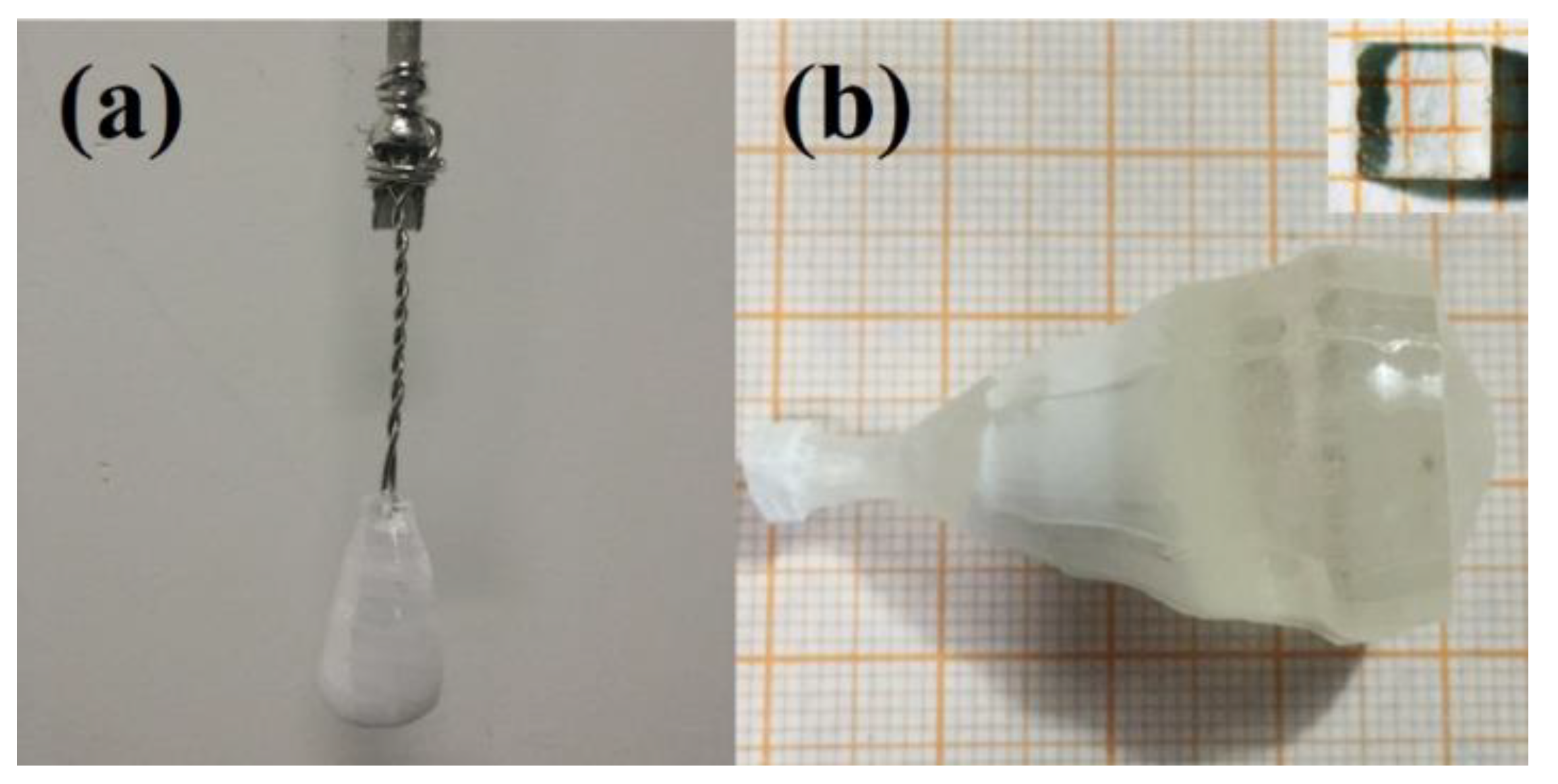

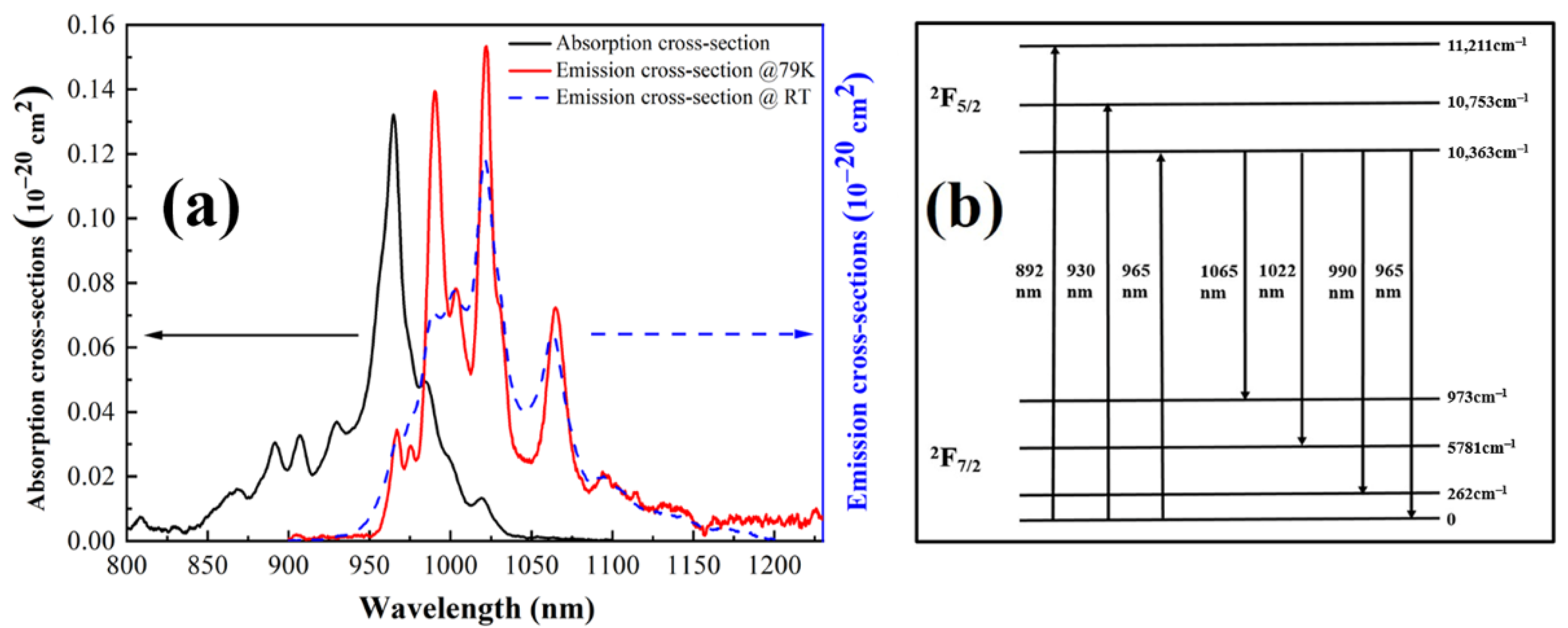
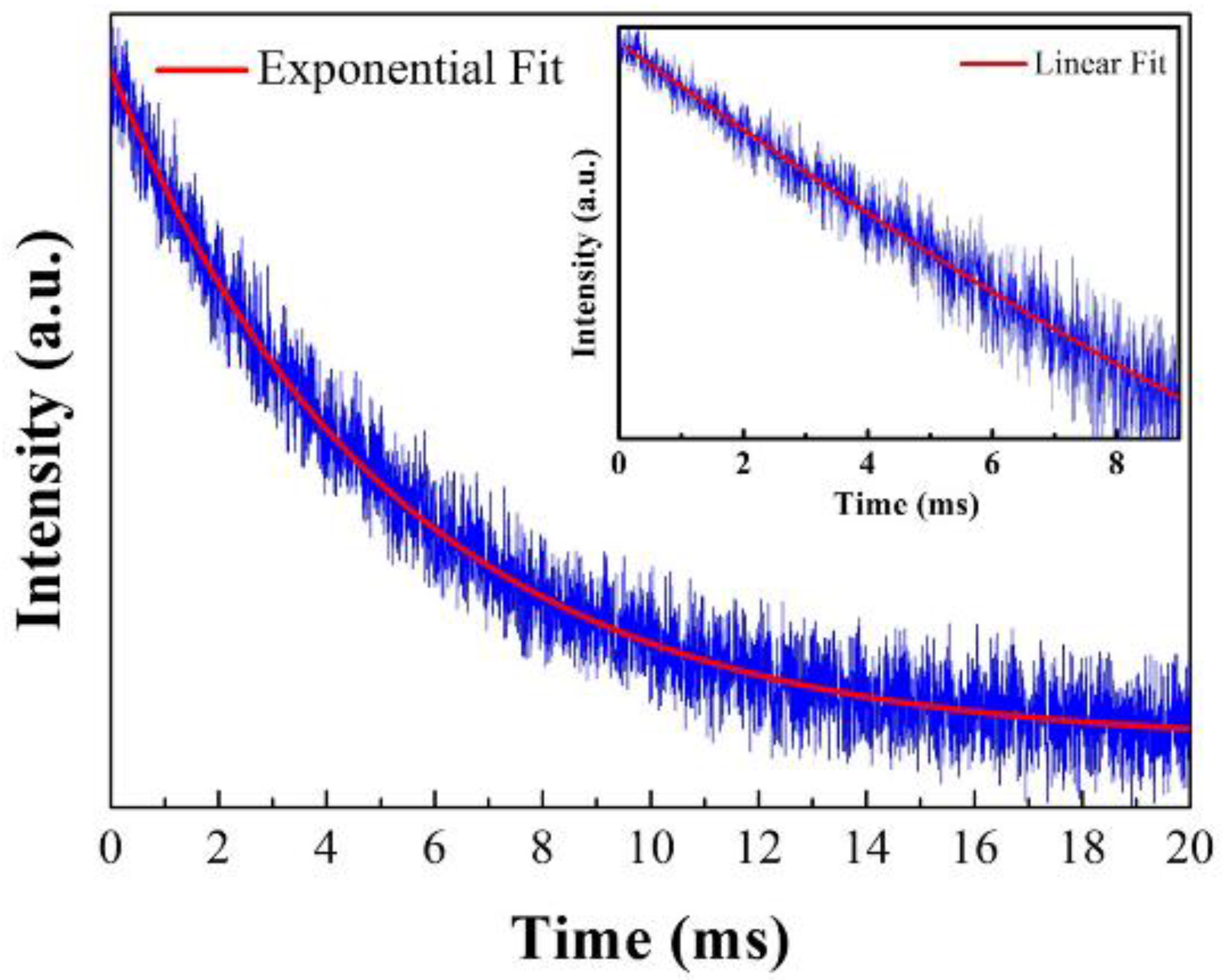
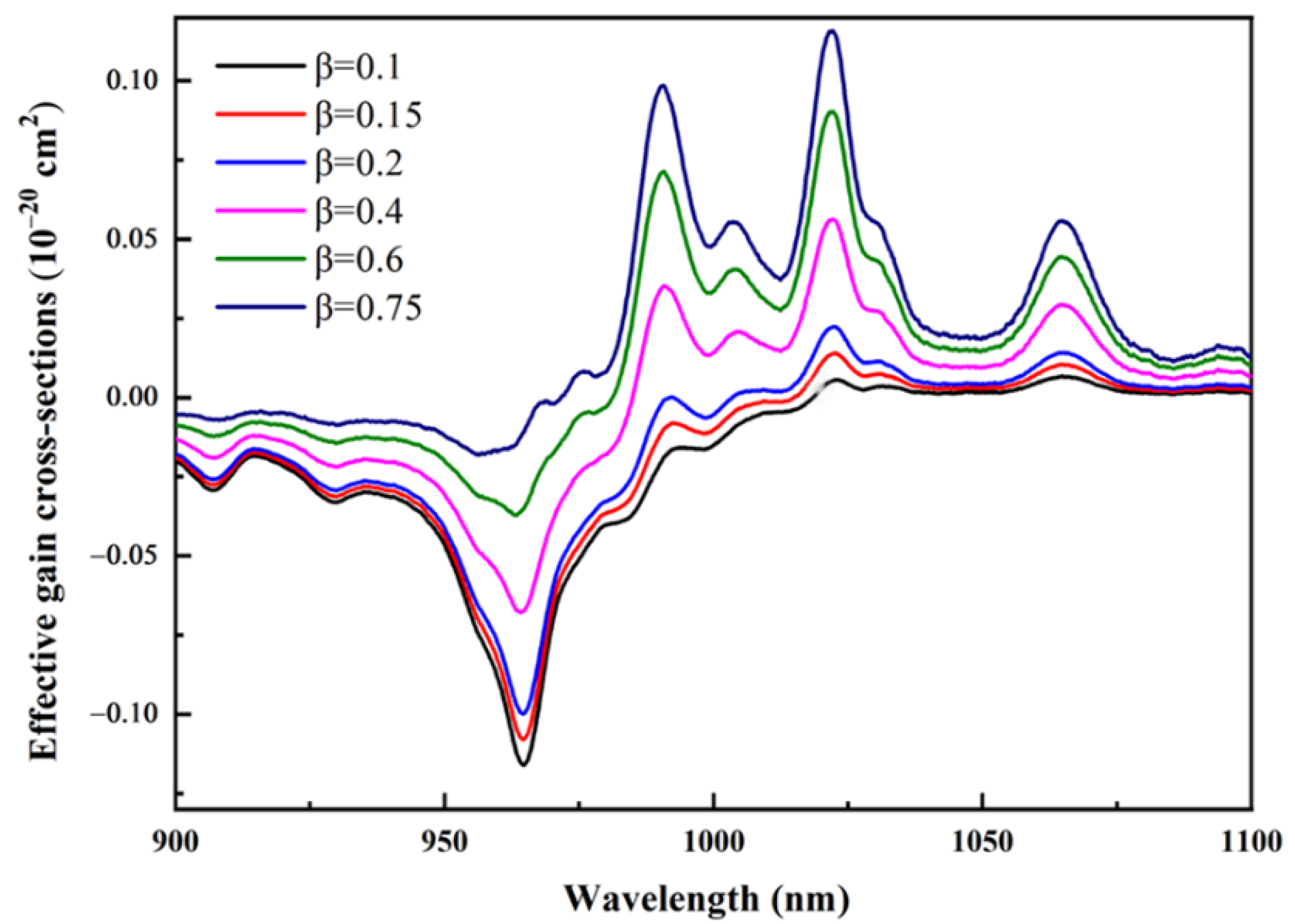

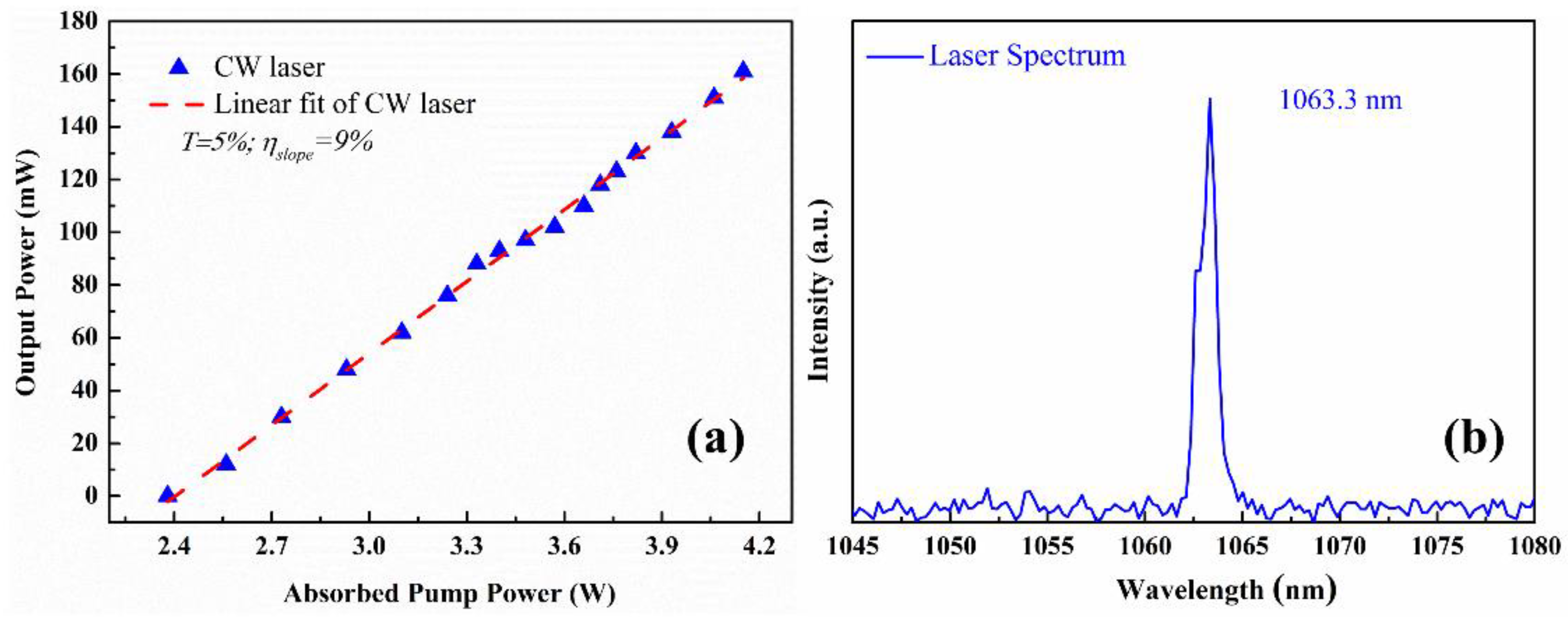

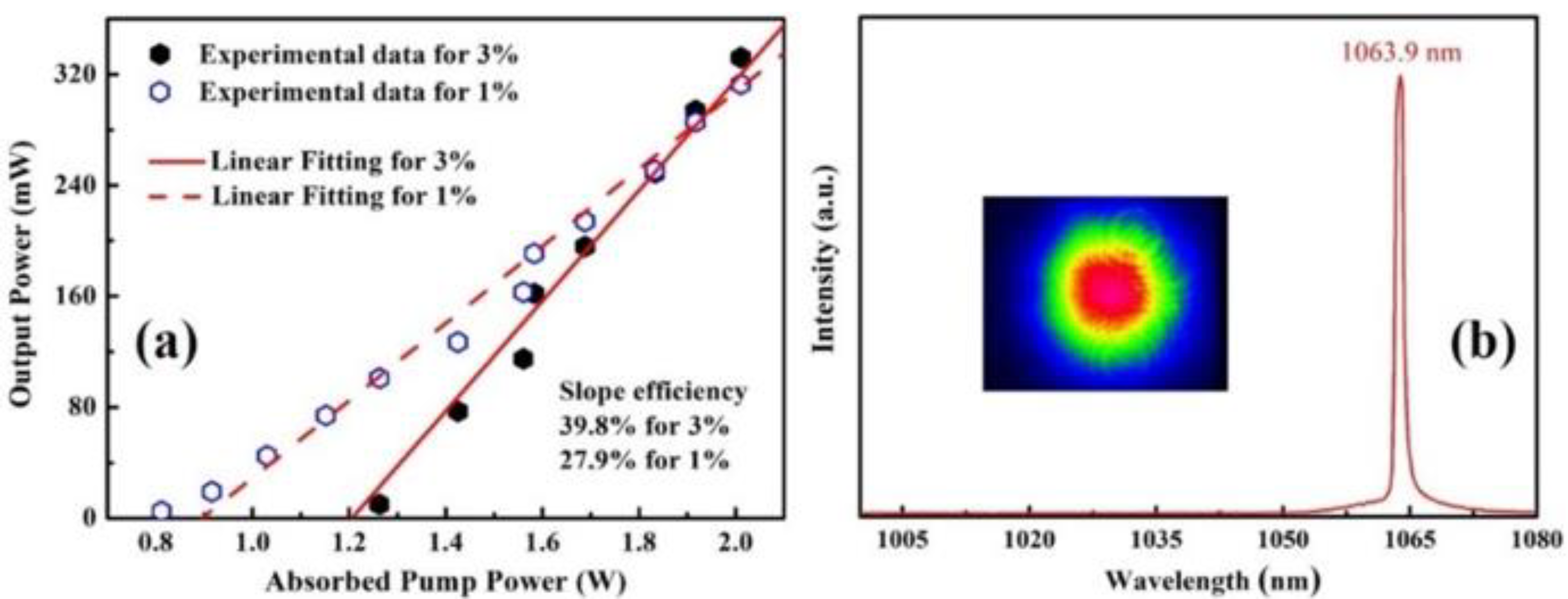
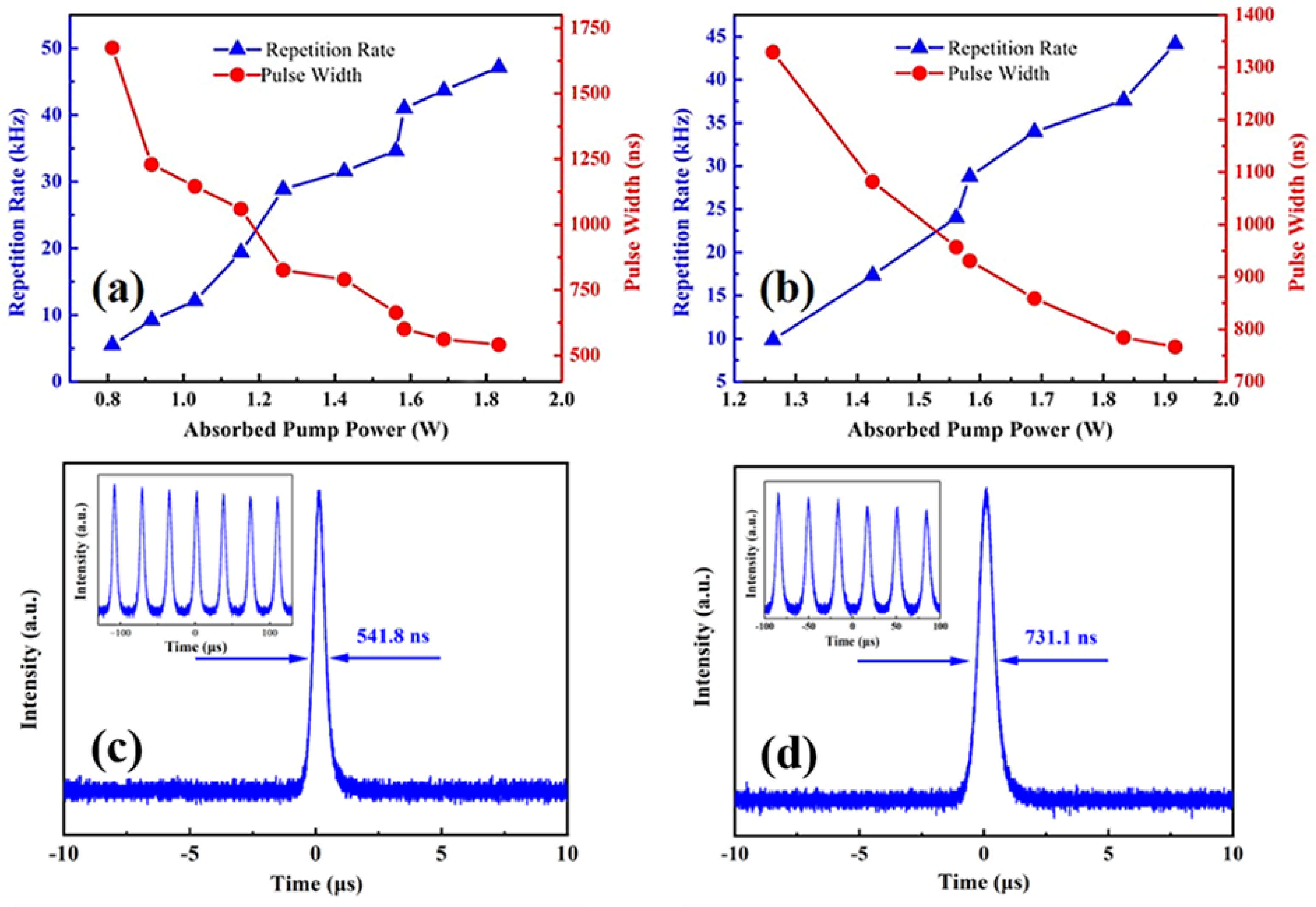
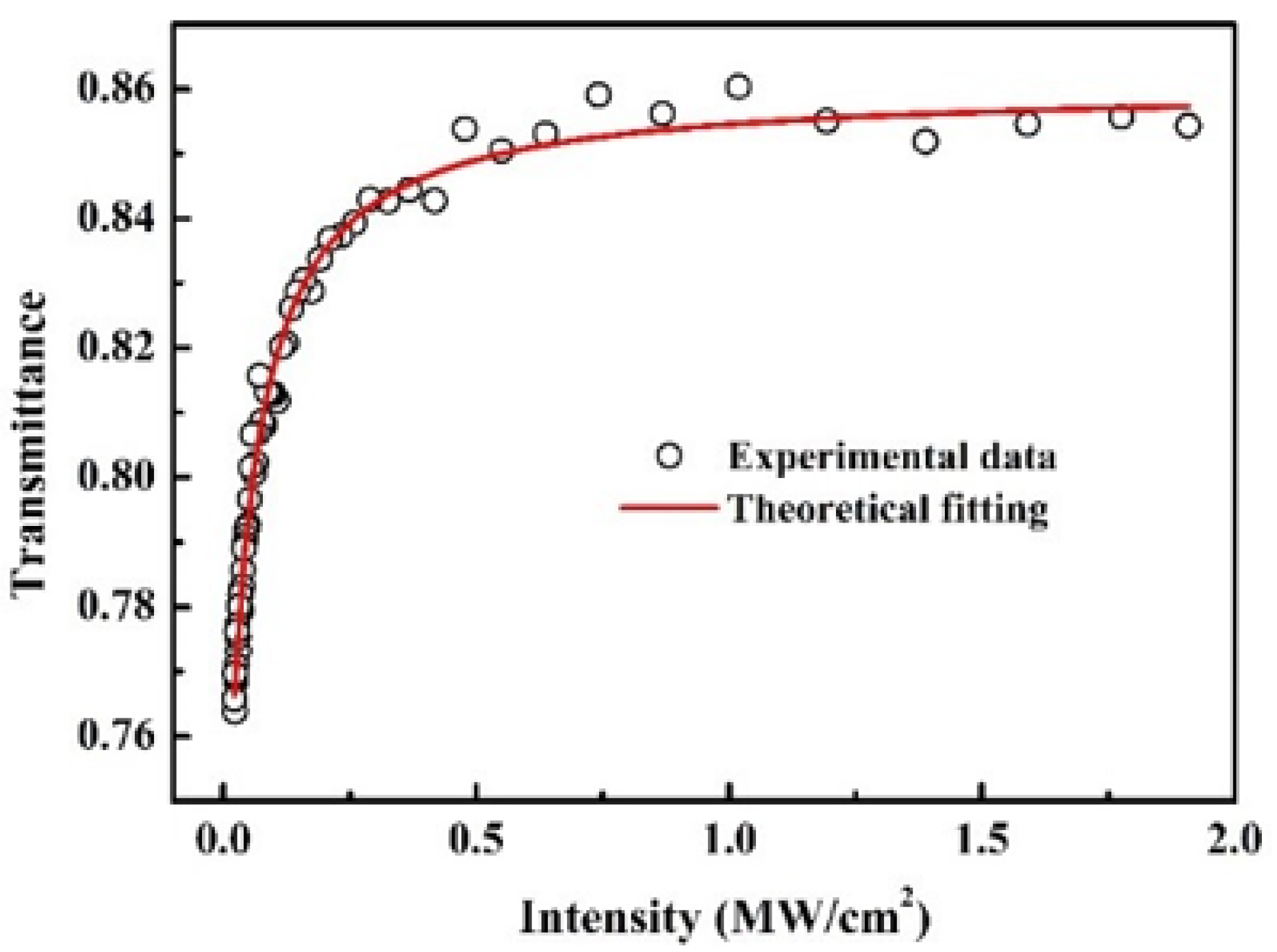
Publisher’s Note: MDPI stays neutral with regard to jurisdictional claims in published maps and institutional affiliations. |
© 2021 by the authors. Licensee MDPI, Basel, Switzerland. This article is an open access article distributed under the terms and conditions of the Creative Commons Attribution (CC BY) license (https://creativecommons.org/licenses/by/4.0/).
Share and Cite
Lu, D.; Li, X.; Yu, H.; Zhang, H.; Wang, J. Review of the Yb3+:ScBO3 Laser Crystal Growth, Characterization, and Laser Applications. Appl. Sci. 2021, 11, 10879. https://doi.org/10.3390/app112210879
Lu D, Li X, Yu H, Zhang H, Wang J. Review of the Yb3+:ScBO3 Laser Crystal Growth, Characterization, and Laser Applications. Applied Sciences. 2021; 11(22):10879. https://doi.org/10.3390/app112210879
Chicago/Turabian StyleLu, Dazhi, Xiaoheng Li, Haohai Yu, Huaijin Zhang, and Jiyang Wang. 2021. "Review of the Yb3+:ScBO3 Laser Crystal Growth, Characterization, and Laser Applications" Applied Sciences 11, no. 22: 10879. https://doi.org/10.3390/app112210879





